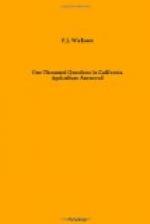The best breed for a man is the one he likes best, providing it has been bred for the purposes he desires to attain. All the breeds you mention are suited to the scheme you outline.
Foothill Dairying.
Is there any risk to run in taking cows to an altitude of 2000 from a much lower one?
There is no quarrel between a cow and a mountain. Ever since the settlement of the State cows have been driven directly from the valley up to the mountain meadow pastures, both for butter and for beef-making, in the summer time. The foothill elevation you mention is only a starting to elevations of 6000 feet and more to which cattle are driven every season.
Bad-Tempered Jerseys.
Jersey bulls are apt to become vicious after a time; is it so to the same extent with bulls of the other named breeds?
The Jersey bull is conceded to be crosser and more dangerous than other bulls, but no bull should ever be allowed to have a chance at a man. Never consider a bull gentle and you will be safe with him.
Breeding in Line.
Is it right and proper to breed a pedigreed registered bull to his daughter, who is the offspring of a grade cow? If it is not right, explain why. If it can be done, will the offspring be physically perfect and an improvement, or will it have poorer qualities than its sire and mother? If this inbreeding can be done successfully, how long can it be carried on, or, in other words, how long could one bull be bred back into his own offspring? Can a herd be perfected in this way?
It is right and proper to breed a registered sire to his daughter, who is the offspring of a grade cow. The first cross is all right and the offspring ought to be physically perfect. This is a first step in what we call line breeding, but in line breeding proper, both animals must be pure bloods and registered, having ancestors on both sides which have a long line of good individuals with strong constitutions and true to type. To do this, one must have a perfect ideal in mind. This line breeding is what has developed the breeds today up to the high standard of perfection. Breeding sire to daughter, if followed along these lines, will be all right; at least, it was so in the case of Amos Cruickshank, the great shorthorn breeder. You cannot successfully breed back on the daughter’s offspring, but if you use a straight out-cross on the daughter’s offspring you can again use this sire on her produce with marked success. In the case of a grade cow and registered sire, there are two things which will make you either lose or win with one cross, and that is regarding the breeding of your sire. If he is just an ordinary-bred fellow it will be a hit-and-miss game, but if he is from a long line of good ancestors on his dam’s side, you can very materially improve the, herd, because always keep in mind the female produce from the sire’s dam will grow with age toward the sire’s dam. So if your first cross from your first sire is all right, use a straight out-cross bull, but be sure he is what he ought to be, and then you can use your old bull back on his heifers. Of course, a man practicing this breeding ought to be a thorough stockman and a first-class judge of live stock. — W. M. Carruthers.




